Photo

neovison vison
American Mink
Visón Americano
The American mink is a carnivorous mammal and an invasive species. It is endangering an indigenous species, the European mink.
It is from the mustelid family and its skin is valuable in the fur industry, there are fur farms where sometimes they escape and roam free in the new environment, where they do not belong naturally.
Activists have also entered these farms and released the American mink, thinking about freeing the animals, but without realizing about the serious impact on the environment.
One of the problems with the American mink is that they are an opportunistic predator and affect seabirds by eating their eggs and hunting on the birds.
The American mink is also displacing in the habitat of the European mink, the American mink steals their food and they also prey on the European minks, now there are only 500 individuals of the European mink left.
European mink now have a disease problem that has been carried over by the American mink. Mink plasmacytosis is an Aleutian disease virus (ADV) that causes a fatal immune deficiency.
To control the American minks, they are trapped and euthanised.
El visón americano es un mamífero carnívoro y una especie invasora. Está poniendo en peligro a una especie autóctona el visón europeo.
Es de la familia mustélido y su piel es valiosa por la industria peletera, hay criadores de granjas donde a veces escapan y entran la naturaleza, donde no pertenecen naturalmente.
También activistas han entrado estas granjas y liberado los visones americanos pensando en liberar los animales, pero sin dar cuenta con un impacto grave por el medio ambiente.
Una de los problemas con el visón americano es que son una depredadora oportunista y afectan las aves marinas se comen los huevos y cazando las aves.
El visón Americano también está desplazando en el habitat del visón europeo se roban su alimentación y cazan los visón europeos, ahora solo quedan 500 individuos del visón europeo.
Los visones europeos ahora tienen una problema por enfermedad que ha portado el visón americano. Visón plasmocitosis es un enfermedad aleutiana del visón (ADV) que provoca una deficiencia inmunitaria mortal.
Para controla los visones americanos, lo capturaron en trampas y se sacrifican.
17 notes
·
View notes
Photo

North African Hedgehog atelerix algirus . Today I want to talk about this small nocturnal creature. I see a lot of them about on my island but normally I unfortunately come across them dead but I have been lucky to see some alive. . . How can you help a hedgehog? . Leave out cat food and water in your garden. Provide a small cave like shelter in the corner of your garden. Make access into and out of your garden by making hedgehog size holes in your fence or a gap under your fence. Don’t use pesticides which kills slugs which is a part of their diet. Ditch your regular garden maintenance and let your grass grow longer than normal. Grow a variety of plants and flowers to attract a wide range of bugs to create the perfect bug buffet. If you have seen a hedgehog in the road whilst driving slow down and let it pass or get out and help him cross the road. If you find an injured hedgehog contact your local wildlife trust! . Tips about the hedgehog: Hedgehogs can not drink milk and it can kill them. Hedgehogs do not only eat slugs and only consists of 10% of their diet. Hedgehogs can’t see well and rely heavily on their noses. . . . . . #hedgehog #scientificillustration #ilustracióncientífica #skull #wildlifeaddicts #wildlifeart #erizo #erizoafricano #africanhedgehog #africanhedgehogs #skullartwork #skullartists #gardencreatures https://www.instagram.com/p/CQQmlQTDcmN/?utm_medium=tumblr
#hedgehog#scientificillustration#ilustracióncientífica#skull#wildlifeaddicts#wildlifeart#erizo#erizoafricano#africanhedgehog#africanhedgehogs#skullartwork#skullartists#gardencreatures
6 notes
·
View notes
Photo
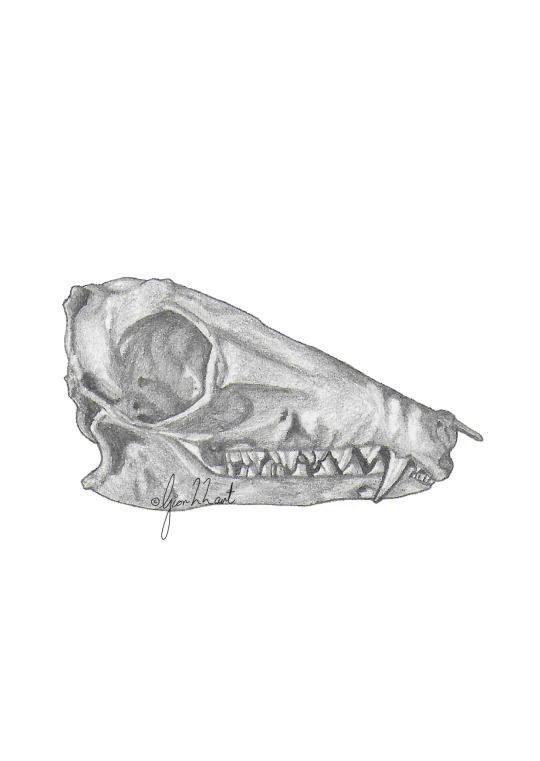
Golden-rumped elephant shrew
Rhynchocyon Chrysopygus
Threats:
They are naturally hunted by snakes, lizards and birds of prey but they suffer major losses from deforestation including fragmented foresting and also getting caught up in traps and then discarded due to the foul taste of their meat making them undesirable as food.
Cool facts:
they are identified by their golden rump (lower back before the tail)
they have long and flexible snouts
they walk on their tippy toes otherwise called semi-digitigrade
the golden-rumped is the largest of the elephant shrews growing a total of 56cms (20in)
they are monogamous and only change partners if one of the pair dies
they defend their territory by tail slapping (slapping their tail into the floor repeatedly)
#shrew#goldenrumpedelephantshrew#elephantshrew#skull#fineart#death#save the species#endangered species#endangered#endangered animal#scientific illustration#scientific facts#gior22skull
8 notes
·
View notes
Photo

All about goats!
Although the goat is not an endangered animal I thought it would be nice to understand the importance of domestic animals and to show how they also play a crucial role in the plant.
First of all some cool facts:
Some goats can have tufts of fur on their face, neck or ears these are called wuttles (often they are removed to help prevent injuries)
Goats are born with teeth and are ready to go and graze soon after being born.
Their upper jaw is larger than its lower jaw, so in order to chew their food they make the rotational movement with their that you can see whilst they eat.
They have four stomachs like many other grazing animals and it can take as long as 15 hours for digestion to occur.
Their square horizontal eyes (which are often considered scary) are evolved so they are not blinded by the sun whilst they graze or forage and also so they can keep an eye on predators.
They were one of the first domesticated animals (after the dog) and were domesticated around 9,000 years ago.
Goats can actually distinguish expressions of people and choose to respond to happy ones.
They have a variety of names these are as follows:
Female - Doe / Nanny
Male - Buck / Billy
Castrated Male - Wether
Young Male - Buckling
Young Female - Doeling
1-2 yrs Young - Kid
Giving Birth - Kidding
A Group - Tribe / Trip
Some other bits that I thought was interesting upon doing my research!
Thor the god of thunder rode a chariot pulled by two goats called Tanngrisnir and Tanngnjóstr (Norse for Teeth Bearer and Teeth Grinder) and has been referred to as "Lord of the Goats"
The ancient Egyptian Pharaoh Cephranes loved goats so much he had 2,200 of them buried along with him!
#goat#goat skull#goat facts#farm facts#farm animal#domestic animal#skull#thor#thor god of thunder#tanngrisnir#tanngnjóstr#lord of the goats#cephranes#pharoah#egypt#gior22skull
2 notes
·
View notes
Photo

Wood Frog
Lithobates Sylvaticus
Rana Sylvatica
The most amazing thing about this frog is its ability to freeze during the winter and thaw out in the spring.
Normally when a heart stops beating an animal is dead, but with the wood frog they can shut down their bodies including its heart and lungs and then defrost itself from within. It is still a scientific mystery on how the body reactivates.
The study of this frog and other biological materials from below normal temperatures is called Cryobiology. Scientists believe if we can learn from the adaptation of the wood frog the knowledge could be used to help with medical problems such as freezing organs until needed and thawing them out for transplants without damage "Cryopreservation"
Not only can they survive being frozen, they can be frozen and defrosted multiple times called freezing episodes and can withstand being frozen for up to 8 months a year normally in episodes of under four weeks at a time.
Even though the frog is frozen on the outside it inhibits a Glucose which is sent to its cells which helps to protect it from getting completely frozen even though its heart is not beating and lungs not breathing. It can be frozen to up to 70% of its total fluids including its eyes and blood.
13 notes
·
View notes
Photo
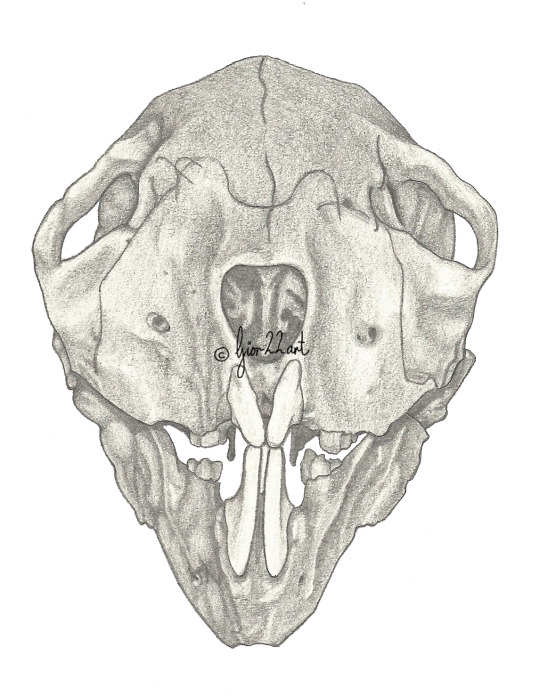
Frontal view of aye aye skull
I’m drawing this for a possible book on endangered wildlife and their anatomy currently focusing on skull and when I get comfortable enough I’ll start looking into the muscular structures if I can find enough references to work from of course!
I’ll put up a mock up book spread or possible poster for the Aye aye in the coming month as a teaser.
But for now enjoy this skull!
Also I have posted a video on my instagram and the full video on youtube
#aye aye#skull#skull work#skull art#skull illustration#animal skull#scientificillustration#scientific illustration#gior22skull#endangered#endangered species
11 notes
·
View notes
Photo

Galapagos Penguin
Spheniscus Mendiculus
Threats:
Natural threats are by land snakes, owls and hawks and by sea sharks, fur seals and sea lions.
Getting unintentionally caught up in fishing nets
Introduction of cats and rats by humans which attack adult penguins and eggs
Avian malaria which is carried by mosquitoes and was brought to the Galapagos by humans
El Niño which directly affects their reproduction by reducing the availability of food and causes a large portion of the population to starve and die.
Climate change is increasing the frequency of extreme El Niño events, making it harder for the Galapagos penguin to recover from the events
Plastic pollution can cause them to suffocate from being strangled from plastic debris such as six pack rings or plastic ropes from boats
What is El Niño?
It is a ocean and atmospheric interaction which causes a periodic warming of the sea surface temperatures most likely occurring during the winter season and lasting anywhere from 6 to 12 months.
Cool Facts:
It is the only penguin found north of the equator
Is one of the smallest penguins in the world
they live in crevices in coastal lava and caves
Galapagos penguins mate for life have just one partner and can breed 2 to 3 times a year
They have adapted some behaviours to try to keep themselves cool from the heat:
standing with the flippers extended
panting
seeking shade
and also have had some feather changes and have bald spots on their faces to help release heat.
#endangerd#endangered animal#endangered species#galapagos#penguin#galapagos penguin#bird#bird skull#skull#skull art#skull illustration#sciart#scientificillustration#scientific illustration#gior22skull
5 notes
·
View notes
Photo
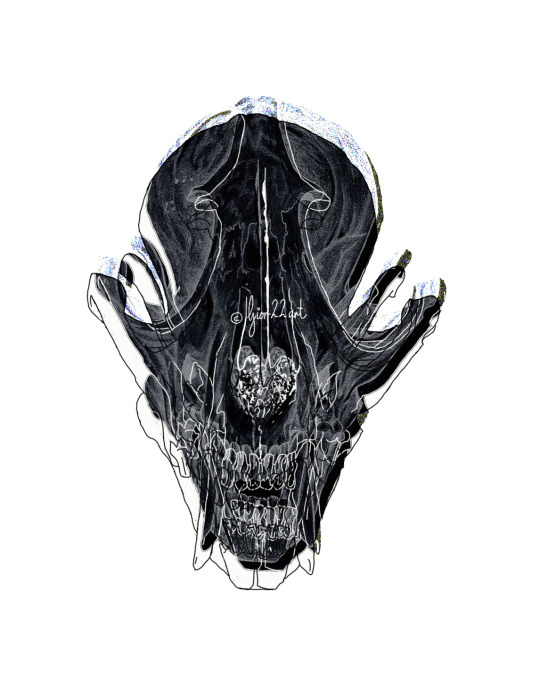
Freaking Fox
A digital edit of a drawing I made showing a skull of a fox glitching between reality and non existence. As if stuck inside the static of a computer screen.
I wanted to show my feelings on life after death, and that how skulls and bones are one of the only ways you can hold into something that once lived and that they have a precious value of the memory of life and also the memory that life never lasts and even one day that bone will too be gone.
#fox#skull#skull art#skull illustration#digital art#digital manipulation#digital#black work#gior22digital
17 notes
·
View notes
Photo
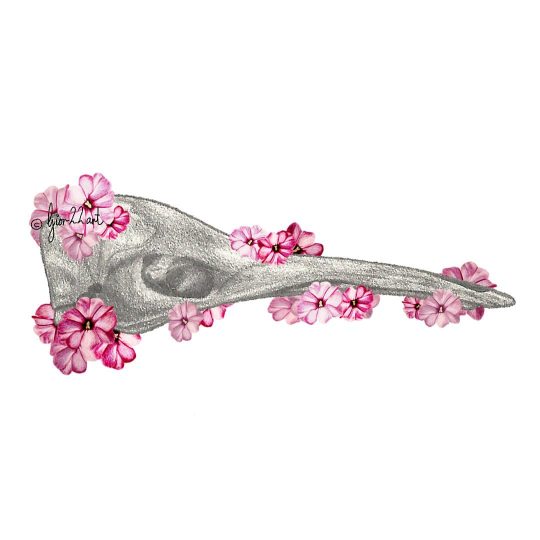
Patiently waiting on impatiens A skull of an long nosed echidna resting on flowers (pink New Guinea impatiens) waiting to be found.
I hope you like this piece it took me a while to sort out the composition but when I fixed it like this I knew this was the one. I originally wanted just one flower on its head but this felt so much better! I’m hoping that this year will bring lots of good fortune and I can start working to so I can buy a printer and start thinking about prints and other special ideas that I have in mind 🌺
https://www.instagram.com/p/CMxHLpGjFbS/?igshid=1v71oqm3ruq5
#echidna#impatiens#flower#bloom#skull#skullart#deathpositive#gior22mixedmedia#neoappart#boneart#magnusartgallery#darktransmissions
3 notes
·
View notes
Photo

Hawksbill Sea Turtle
Eretmochelys Imbricata
Facts about~
Sea turtles have existed for the last 100 million years.
They have a narrow pointy beak like a bird to reach into small nooks in the coral to search for food.
The main type of food for the hawksbill sea turtle are coral reef sponges, for most animals these are toxic making the competition very small.
They also eat mollusks, marine algae, crustaceans, sea urchins, jellyfish and fish.
They have a pair of claws on each flipper, with the males having longer claws than females.
Males also have thicker tails and brighter colours than females.
Threats against~
Since the times of the Ancient Egyptians the tortoise shell has been a prize for humans.
The tortoise shell trade still illegally goes on today and is still used to make hair ornaments, jewellery and decorative objects. It is still frequently confiscated by the customs office.
In Japan the shell is even used on traditional Japanese wedding dresses, the shell is called “bekko”.
Plastic bags mistaken for jellyfish leave the turtle choking, those that survive eating the plastic, end up accumulating plastic in their stomach leading to a false sensation of being full and die of starvation or internal blockages and cuts by sharp plastic and eventually all lead to death.
Hawksbill eggs are also still eaten around the world and even the flesh of the turtle in some occasions despite their protected status.
Accidental capture in fishing nets is causing to be a problem, the turtles get caught up in the nets and then drown to death if not cut out in time.
Other problems include coastal development leading to less beaches for them to nest on.
Also climate change and coral bleaching which are destroying their habitats and killing corals, which is leading to less food abundance.
#turtle#seaturtle#hawksbill sea turtle#sea turtle#skull#bone#dark art#animal skull#artists on tumblr#gior22skull
19 notes
·
View notes
Photo
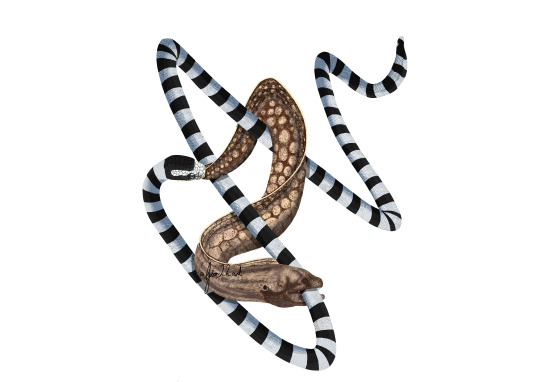

The Dance of Death
Yellow Lipped Sea Krait VS Giant Moray Eel
Laticauda Colubrina VS Gymnothorax Javanicus
22 notes
·
View notes
Photo
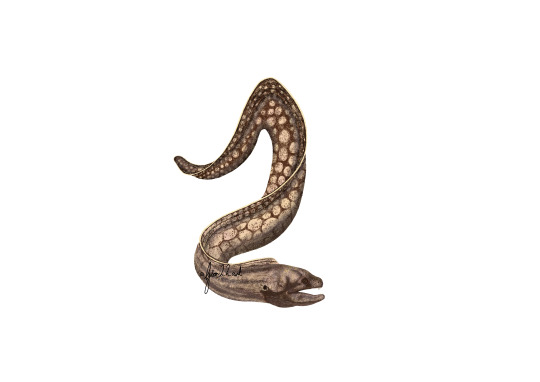
Giant Moray Eel
Gymnothorax Javanicus
Facts~
Moray eels are a group containing around 200 different species.
They normally stay hidden between corals and rocks waiting for prey to pass by before eating them.
They are covered in slime which helps them glide through the water in a friction-less way and is also used as a glue like substance to help build sand burrows.
The slime also attracts parasites and those parasites attract its prey.
They have small round eyes at the end of their snout, but have poor vision and rely on motion and smell.
They can co-operate with other fish for hunting and learn the routine of their prey.
They have two sets of teeth the inner set it used to drag helpless prey down their throat.
They are the only known animal that uses their second set of jaws (pharyngeal jaws) as a weapon.
They are nocturnal and hunt only in the night.
They can lay up to 60,000 eggs at once and the parents have nothing to do with them after they are born so lots get eaten up.
7 notes
·
View notes
Photo
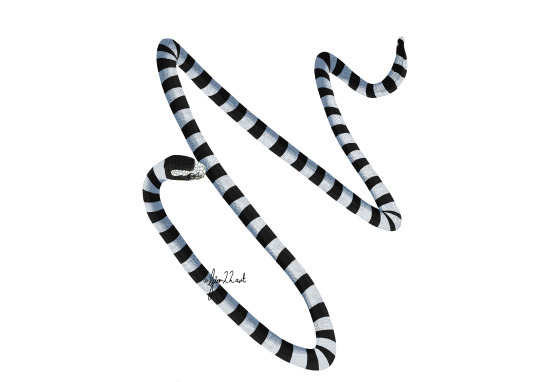
Yellow Lipped Sea Krait
Laticauda Colubrina
Facts~
Have over five different names! Which include of Banded Sea Krait, Colubrine sea snake, yellow lipped sea snake and more!
It’s key characteristic is it’s flattened tail which acts like a paddle helping it swim through the water.
They can only move at one 5th of the speed on land than it can in water.
It spends an equal amount of time on sea than in water unlike most other sea snakes and kraits which cannot move on land at all.
They eat eels and small fish and are preyed upon by sharks, larger fish and birds whilst on land.
They can fool predators from the movement of their tail into thinking it is their head.
The venom makes it one of the most lethal creature of the sea being 10x more potent than a rattle snake.
Like turtle it returns to land to lay eggs.
They have a salt gland under their tongue which removes salt absorbed from the sea.
They also have the ability to breathe through their lungs and their skin.
#krait#sea snake#banded krait#banded sea snake#yellow lipped sea krait#snake#colubrine sea snake#gior22digital
6 notes
·
View notes
Photo
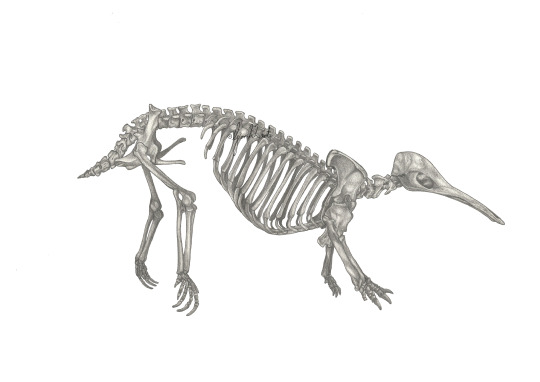
Western long-beaked echidna
Zaglossus Bruijnii
Facts~
It’s in a species group called “monotreme” which is where the mammal produces milk for their young, but unlike other mammals lays egg instead of live young.
Instead of having nipples they have milk glands which is inside a pouch (just like a marsupial e.g. a kangaroo).
The young are called “puggle”
They are related to platypus.
They only have one exit... meaning urination, defecation and reproduction all happen in the same place, it is called the “cloaca”.
Monotreme’s have changed little over 100 million years according to fossil evidence.
Are thought to be nocturnal but little is known about their activities, they can burrow for days at a time and it is still unknown why they do this.
They have no ability to bite or chew and can only suck up their prey which normally includes of earthworms.
The beak has electrical receptors and can detect faint movement in electrical fields produced by its prey.
They don’t have any tail.
They are covered in spikes and curl up just like hedgehogs to protect themselves from predators.
They can lift twice their body weight.
They are not social and normally roam around alone.
The name echidna is from a Greek mythological monster who was half-snake and half-woman, who is also the mother to many other Greek monsters. According to tribal hunters the echidna is the offspring of a python snake. Which could possibly be related to each other.
Knuckles from Sonic the hedgehog is a red echidna.
Threats~
Human’s hunt down the echidna using trained dogs to sniff out their burrows.
They are a tribal favourite meal for 800 different tribes with 7.3 million mouths to feed and most with a craving for echidna, with it as one of their main sources of protein.
Habitat loss due to deforestation driven by mining, agriculture and logging.
4 notes
·
View notes
Photo

Dhole skull laying in the swaying grasses.
8 notes
·
View notes
Photo
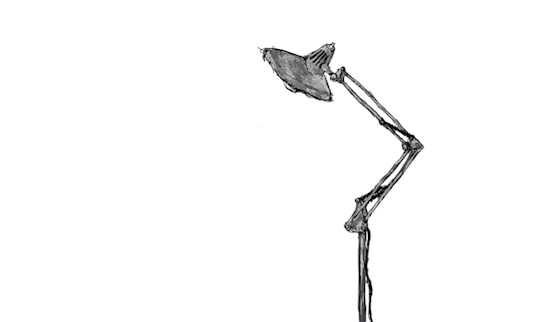
A small GIF of my FASE lamp that hovers over my work space
2 notes
·
View notes
Photo

Reindeer or Caribou
Rangifer Tarandus
I drew this Caribou skull with antlers shedding naturally its velvets, to represent the masses of reindeer that get killed in the poaching of antlers before they even get a chance to shed. So this is my representation of a singular soul that died with just the wish to shed his antlers and live past his newly grown antlers.
Facts about the caribou~
They have hollowed out hooves, which are useful in the winter for finding their all-important food source under the snow, lichen… this digging process for finding lichen is called cratering.
It is the only member of the deer family that both the males and females grow antlers.
Females use their antlers to help defend food sources whilst nursing calves.
Velvet covered antlers contain a hormone called IGF-1 which helps the rapid growth of the antlers growing at a rate of 1-inch per day.
They have scent glands on their ankles and they can release the scent to warn other members of the heard of danger.
In the joint of their feet the tendons click, which helps the heard stay together in low visible weather or darkness.
Rudolph the red nosed reindeer has been argued to be female, as males do not have intact antlers during December.
Threats to caribou~
Whilst females are calving the calf mortality rate is 50% due to human disturbance. Also recent studies have shown that the Caribou have changed their calving grounds due to increased mining surveys and the increasing population of wolves.
Illegal poaching by humans for meat, fur and also their velvet antlers, in which they would be cut off and die of either a fatal infection or blood loss.
Velvet antlers are used as a Chinese medicine sold as antler velvet soups or powders and are used to treat various conditions.
Climate Change is causing food that they find in the winter to ice over which is leading to starvation and death. Climate change is also causing False and early springs changing their migratory patterns and frozen winters thawing out early causing the drowning of calves.
Hotter summers leading to more insects, causing irritation during feeding leading to less build-up of fat and nutrients for the winter and both adults and calves having a lower survival rate and being unable to last the whole cold winter periods.
173 notes
·
View notes